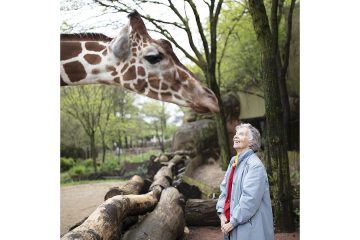Peter Rainer in The Christian Science Monitor:
 When Canadian biologist Anne Innis Dagg was 3 years old, her mother took her to the zoo for the first time. There she saw her first giraffe, and a lifelong love affair ensued. And who can blame her? Is there any other four-legged creature whose looks are more magisterially goofy? Dagg is the focus of Alison Reid’s “The Woman Who Loves Giraffes,” and it confirms a long-held tenet of mine: If the subject of a documentary is fascinating, it doesn’t much matter if the filmmaking is workmanlike. Now in her 80s, Dagg is such a singular personality that everything about her seems sprightly and newly minted.
When Canadian biologist Anne Innis Dagg was 3 years old, her mother took her to the zoo for the first time. There she saw her first giraffe, and a lifelong love affair ensued. And who can blame her? Is there any other four-legged creature whose looks are more magisterially goofy? Dagg is the focus of Alison Reid’s “The Woman Who Loves Giraffes,” and it confirms a long-held tenet of mine: If the subject of a documentary is fascinating, it doesn’t much matter if the filmmaking is workmanlike. Now in her 80s, Dagg is such a singular personality that everything about her seems sprightly and newly minted.
At 23, in the summer of 1956, with a master’s degree in biology, she traveled alone to South Africa during a time of mounting political unrest in order to study up close her beloved giraffes. Other than a Scottish study of red deer, she was the first person to venture into the wilds to investigate animal behavior. This was years before either Jane Goodall or Dian Fossey embarked on their work with chimpanzees and mountain gorillas. Her dogged independence had a rich pedigree: Her mother, Mary Quayle, was the dean of women at the University of Toronto’s University College; her father, Harold Innis, was a famous economist. Thanks to the welcoming ministrations of Alexander Matthew, whose citrus and cattle ranch was also home to many free-roaming giraffes, Dagg was able to closely observe these magnificent animals. Her research was groundbreaking, and the 16 millimeter color footage she shot at the time, amply displayed in the documentary, is breathtaking. (I was especially grateful that Dagg didn’t photograph any maulings or attacks – an unfortunate ingredient in far too many wildlife documentaries.)
More here.
